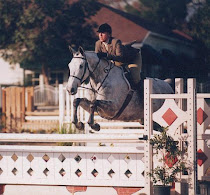Tuesday, February 14, 2012
Thursday, February 2, 2012
It's the Impar Ligament this time
Lack of blogging due to lack of time, and a frustrating horse situation. But here's an update on my mare Mazzy. After my first (and only) show over fences I was gearing up for another one a couple of weeks later, over Labor Day weekend (I know it was a very long time ago), and Mazzy came up lame. After a vet check, she blocked out to the heel and x-rays showed nothing, so the vet thought it was probably soft tissue damage in the foot and needed an MRI to determine exactly what was going on. An MRI showed a strain to the impar ligament (connecting the navicular bone to the back of the coffin bone). Not a horrible diagnosis, since it could have been loads of other worse things.
So the plan was a Tildren regional perfusion and then IRAP injections. Tildren works by preventing bone resorption by inhibiting the activity of osteoclasts, and it also has anti-inflammatory actions. While it will not have any effect on the impar ligament or other soft tissue in the foot per se, the impar ligament attaches to both the distal end of the navicular bone and the bottom surface of the coffin bone, and these attachment sites often undergo degeneration when the ligament itself is damaged. An intravenous catheter is used to administer a large amount of the drug as an intravenous drip for about an hour.
IRAP was used to inject into the coffin joint to promote healing. She had a total of four injections at 2 week intervals. IRAP is a system that has been developed to stimulate white blood cells to produce anti-inflammatory mediators and enzymes to reduce the inflammatory phase. Blood is taken from the jugular vein and incubated for 24 hours in special syringes which induce the blood cells to produce and secrete therapeutic proteins during the incubation period. After 24 hours the blood is centrifuged and all blood cells are removed. This leaves a protein rich serum which is then split into 3ml doses ready for injection. The main anti-inflammatory protein produced is Interleukin-1 Receptor Antagonist Protein (IRAP). This has a direct action on the action of Interleukin-1 which other therapies are unable to do. There are a number of other anti-inflammatory proteins produced during the incubation process which work synergistically with the Interleukin-1 antagonist to reduce the inflammation within the joint and stimulate a regenerative response by the cartilage cells. IRAP is different to other treatments available as it has an anti-inflammatory component which other products have but it also induces a regenerative response unseen in other therapies.
During this time I was hand walking her and switched her to bar shoes with Equithane for heel support. After 3 months or so of this and many vet visits, she was sound. I started saddle walking her working up to 45 min/day. After 30 days of saddle walking, I started trotting beginning with 5 min/day after 30 minutes of walking. On day 5 of trotting Dec 23rd....LAME again. I am so frustrated! I had the whole week off of work from Christmas to New Year's, looking forward to riding in the daylight everyday, and back to square one. So at this point I am still saddle walking.
I invested in The Bio-Pulse Iron Foot PEMF Pad. There have been many studies on PEMF shown to provide pain relief, reduce swelling, control inflammation and speed healing time. The PEMF, i.e. (Magna Pulse, Magna Wave, P3 etc.) is a revolutionary medical device that has shown amazing results in the treatment of pain and swelling, wounds, bone fractures, as well as in dramatically improving range of motion in both humans and animals. The PEMF uses powerful pulsed electro- magnetic field that provides natural energy to the cells of the body. PEMF therapy improves circulation, not by increasing heartbeat or blood pressure, but by opening and dilating the arteries and capillaries. This also reduces edema (swelling). PEMF therapy increases the cellular level of oxygen absorption. Studies have shown that oxygen partial pressure can be increased by 200%. This reduces pain associated with lack of sufficient oxygen. Also, insufficient oxygen in the cells causes lactic acid buildup under strenuous exercise. Good information here: http://www.pemf.co.nz/Questions-Answers-about-PEMF
She stands on it for 30 min/day. This thing better work!!!
Yellow = deep digital flexor tendon
Blue = navicular bone
Orange = impar ligament
Red = intersection of ligament and tendon
So the plan was a Tildren regional perfusion and then IRAP injections. Tildren works by preventing bone resorption by inhibiting the activity of osteoclasts, and it also has anti-inflammatory actions. While it will not have any effect on the impar ligament or other soft tissue in the foot per se, the impar ligament attaches to both the distal end of the navicular bone and the bottom surface of the coffin bone, and these attachment sites often undergo degeneration when the ligament itself is damaged. An intravenous catheter is used to administer a large amount of the drug as an intravenous drip for about an hour.
IRAP was used to inject into the coffin joint to promote healing. She had a total of four injections at 2 week intervals. IRAP is a system that has been developed to stimulate white blood cells to produce anti-inflammatory mediators and enzymes to reduce the inflammatory phase. Blood is taken from the jugular vein and incubated for 24 hours in special syringes which induce the blood cells to produce and secrete therapeutic proteins during the incubation period. After 24 hours the blood is centrifuged and all blood cells are removed. This leaves a protein rich serum which is then split into 3ml doses ready for injection. The main anti-inflammatory protein produced is Interleukin-1 Receptor Antagonist Protein (IRAP). This has a direct action on the action of Interleukin-1 which other therapies are unable to do. There are a number of other anti-inflammatory proteins produced during the incubation process which work synergistically with the Interleukin-1 antagonist to reduce the inflammation within the joint and stimulate a regenerative response by the cartilage cells. IRAP is different to other treatments available as it has an anti-inflammatory component which other products have but it also induces a regenerative response unseen in other therapies.
During this time I was hand walking her and switched her to bar shoes with Equithane for heel support. After 3 months or so of this and many vet visits, she was sound. I started saddle walking her working up to 45 min/day. After 30 days of saddle walking, I started trotting beginning with 5 min/day after 30 minutes of walking. On day 5 of trotting Dec 23rd....LAME again. I am so frustrated! I had the whole week off of work from Christmas to New Year's, looking forward to riding in the daylight everyday, and back to square one. So at this point I am still saddle walking.
I invested in The Bio-Pulse Iron Foot PEMF Pad. There have been many studies on PEMF shown to provide pain relief, reduce swelling, control inflammation and speed healing time. The PEMF, i.e. (Magna Pulse, Magna Wave, P3 etc.) is a revolutionary medical device that has shown amazing results in the treatment of pain and swelling, wounds, bone fractures, as well as in dramatically improving range of motion in both humans and animals. The PEMF uses powerful pulsed electro- magnetic field that provides natural energy to the cells of the body. PEMF therapy improves circulation, not by increasing heartbeat or blood pressure, but by opening and dilating the arteries and capillaries. This also reduces edema (swelling). PEMF therapy increases the cellular level of oxygen absorption. Studies have shown that oxygen partial pressure can be increased by 200%. This reduces pain associated with lack of sufficient oxygen. Also, insufficient oxygen in the cells causes lactic acid buildup under strenuous exercise. Good information here: http://www.pemf.co.nz/Questions-Answers-about-PEMF
She stands on it for 30 min/day. This thing better work!!!
Posted by Five O'Clock Somewhere at 5:01 PM 3 comments
Labels: Horse, Mazzy, veterinarian
Subscribe to:
Posts (Atom)
























